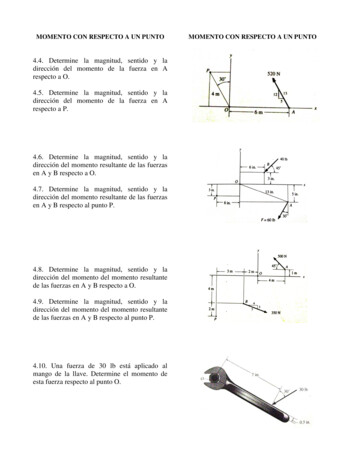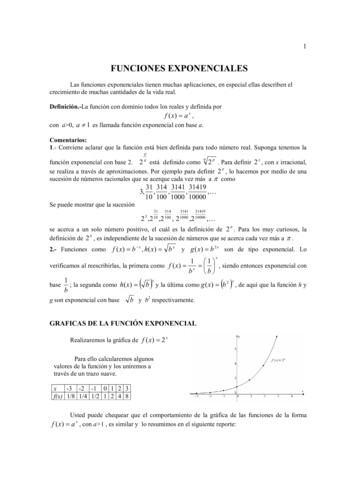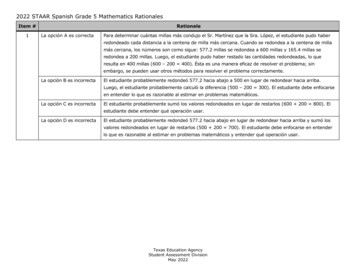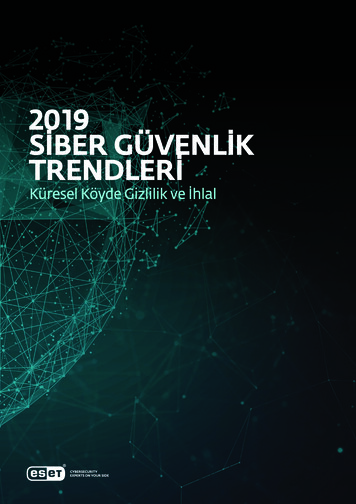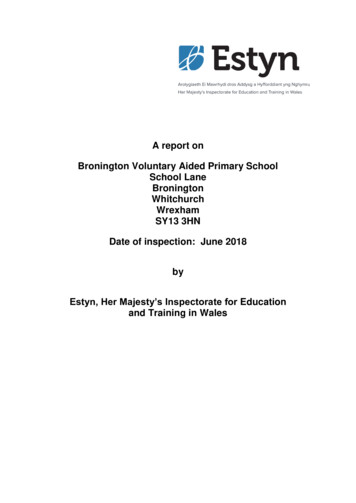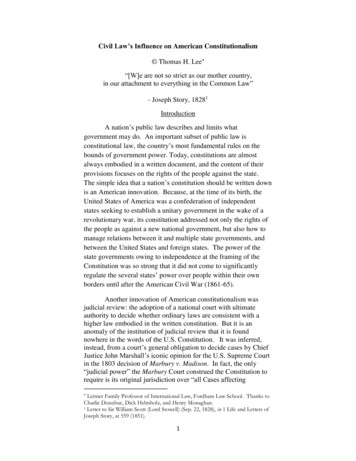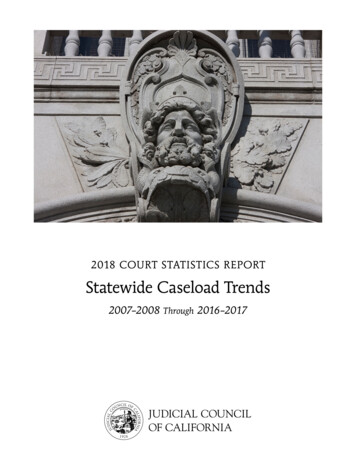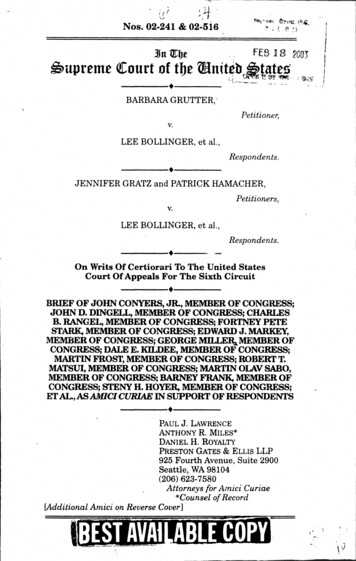
Transcription
gf'e., i,' t'Nos. 02-241 & 02-516ti"4:,.-FEB3 183hn Ejesupreme200Court of the Eniteb :tatesI.%tBARBARA GRUTTER,Petitioner,v.LEE BOLLINGER, et al.,Respondents.JENNIFER GRATZ and PATRICK HAMACHER,Petitioners,v.LEE BOLLINGER, et al,Respondents.On Writs Of Certiorari To The United StatesCourt Of Appeals For The Sixth CircuitBRIEF OF JOHN CONYERS, JR., MEMBER OF CONGRESS;JOHN D. DINGELL, MEMBER OF CONGRESS; CHARLESB. RANGEL, MEMBER OF CONGRESS; FORTNEY PETESTARK, MEMBER OF CONGRESS; EDWARD J. MARKEY,MEMBER OF CONGRESS; GEORGE MILLERRMEMBER OFCONGRESS; DALE E. KILDEE, MEMBER OF CONGRESS;MARTIN FROST, MEMBER OF CONGRESS; ROBERT T.MATSUI, MEMBER OF CONGRESS; MARTIN OLAV SABO,MEMBER OF CONGRESS; BARNEY FRANK, MEMBER OFCONGRESS; STENY H. HOYER, MEMBER OF CONGRESS;ET AL., AS AMICI CURIAE IN SUPPORT OF RESPONDENTSPAUL J. LAWRENCEANTHONY R. MILES*DANIEL H. ROYALTYPRESTON GATES & ELLIS LLP925 Fourth Avenue, Suite 2900Seattle, WA 98104(206) 623-7580Attorneys for Arici Curiae*Counsel of Record[Additional Amici on Reverse Cover]ycw1!AI i 1l1BEST AVAi. .N )
Additiolw Amici CuriaeLANE EVANS, MEMBER OF CONGRESS; MARCY KAPTUR,MEMBER OF CONGRESS; GERALD D. KLECZKA,MEMBER OF CONGRESS; SOLOMON P. ORTIZ, MEMBER OFCONGRESS; MAJOR R. OWENS, MEMBER OF CONGRESS; JOHN M.SPRATT, JR., MEMBER OF CONGRESS; EDOLPHUS TOWNS,MEMBER OF CONGRESS; PETER J. VISCLOSKY, MEMBER OFCONGRESS; JOHN LEWIS, MEMBER OF CONGRESS; FRANKPALLONE, JR., MEMBER OF CONGRESS; NANCY PELOSI, MEMBEROF CONGRESS; LOUISE MCINTOSH SLAUGHTER, MEMBER OFCONGRESS; ROBERT E. ANDREWS, MEMBER OF CONGRESS; NITAM. LOWEY, MEMBER OF CONGRESS; JIM MCDERMOTT, MEMBEROF CONGRESS; DONALD PAYNE, MEMBER OF CONGRESS; JOSE E.SERRANO, MEMBER OF CONGRESS; NEIL ABERCROMBIE, MEMBEROF CONGRESS; DAVID E. PRICE, MEMBER OF CONGRESS; ROSA L.DELAURO, MEMBER OF CONGRESS; WILLIAM JEFFERSON,MEMBER OF CONGRESS; JOHN W. OLVER, MEMBER OFCONGRESS; ED PASTOR, MEMBER OF CONGRESS; BERNARDSANDERS, MEMBER OF CONGRESS; MAXINE WATERS,MEMBER OF CONGRESS; XAVIER BECERRA, MEMBER OFCONGRESS; SANFORD D. BISHOP, JR., MEMBER OF CONGRESS;CORRINE BROWN, MEMBER OF CONGRESS; SHERROD BROWN,MEMBER OF CONGRESS: JAMES E. CLYBURN, MEMBER OFCONGRESS; SAM FARR, MEMBER OF CONGRESS; BOBFILNER, MEMBER OF CONGRESS; LUIS V. GUTIERREZ,MEMBER OF CONGRESS; ALCEE L. HASTINGS, MEMBER OFCONGRESS; MAURICE D. HINCHEY, MEMBER OF CONGRESS;EDDIE BERNICE JOHNSON, MEMBER OF CONGRESS; ROBERTMENENDEZ, MEMBER OF CONGRESS; LUCILLE ROYBALALLARD, MEMBER OF CONGRESS; BOBBY L. RUSH, MEMBEROF CONGRESS; ROBERT C. SCOTT, MEMBER.OF CONGRESS;BENNIE G. THOMPSON, MEMBER OF CONGRESS; NYDIA M.VELAZQUEZ, MEMBER OF CONGRESS; MELVIN L. WATT,MEMBER OF CONGRESS; LYNN WOOLSEY, MEMBER OFCONGRESS; ALBERT R. WYNN, MEMBER OF CONGRESS;ELIJAH CUMMINGS, MEMBER OF CONGRESS; MICHAELF. DOYLE, MEMBER OF CONGRESS; SHEILA JACKSON LEE,MEMBER OF CONGRESS; JESSE JACKSON, JR., MEMBER OFCONGRESS; CHAKA FATTAH, MEMBER OF CONGRESS; ZOELOFGREN, MEMBER OF CONGRESS; JUANITA MILLENDERMCDONALD, MEMBER OF CONGRESS; JULIA M. CARSON,
MEMBER OF CONGRESS; DANNY K. DAvIS, MEMBER OFCONGRESS; WILLIAM D. DELAHUNT, MEMBER OF CONGRESS;HAROLD E. FORD, JR., MEMBER OF CONGRESS; RUBENHINOJOSA, MEMBER OF CONGRESS; CAROLYN C. KILPATRICK,MEMBER OF CONGRESS; DENNIS KUCINICH, MEMBER OFCONGRESS; BARBARA LEE, MEMBER OF CONGRESS; JAMES P.MCGOVERN, MEMBER OF CONGRESS; GREGORY W. MEEKS,MEMBER OF CONGRESS; SILVESTRE REYES, MEMBER OFCONGRESS; CIRO D. RODRIGUEZ, MEMBER OF CONGRESS;LORETTA SANCHEZ, MEMBER OF CONGRESS; ADAM SMITH,MEMBER OF CONGRESS; JOHN F. TIERNEY, MEMBER OFCONGRESS; ROBERT WEXLER, MEMBER OF CONGRESS; JOEBACA, MEMBER OF CONGRESS; TAMMY BALDWIN, MEMBER OFCONGRESS; MICHAEL E. CAPUANO, MEMBER OF CONGRESS;JOSEPH CROWLEY, MEMBER OF CONGRESS; CHARLES A.GONZALEZ, MEMBER OF CONGRESS; BARON HILL, MEMBER OFCONGRESS; STEPHANIE TUBBS JONES, MEMBER OFCONGRESS; GRACE NAPOLITANO, MEMBER OF CONGRESS;JANICE D. SCHAKOWSKY, MEMBER OF CONGRESS;TOM UDALL, MEMBER OF CONGRESS; ANTHONYWEINER,MEMBER OF CONGRESS; DAVID WU, MEMBER OFCONGRESS; WILLIAM LACY CLAY, MEMBER OF CONGRESS;MIKE HONDA, MEMBER OF CONGRESS; BETTY MCCOLLUN,,MEMBER OF CONGRESS; ADAM SCHIFF, MEMBER OFCONGRESS; HILDA SOuS, MEMBER OF CONGRESS; DIANEWATSON, MEMBER OF CONGRESS; RAOL M. GRIJALVA,MEMBER OF CONGRESS; LINDA T. SANCHEZ, MEMBER OFCONGRESS; FRANK W. BALLANCE, JR., MEMBER OFCONGRESS; KENDRICK B. MEEK, MEMBER OF CONGRESS;JIM COOPER, MEMBER OF CONGRESS; CHRIS VAN HOLLEN,MEMBER OF CONGRESS; EDWARD CASE, MEMBEROF CONGRESS; ARTUR DAVIS, MEMBER OF CONGRESS;DLNISE L. MAJETTE, MEMBER OF CONGRESS; MADELEINE Z.BORDALLO, DELEGATE; JIM ENI FALEOMAVAEGA, DELEGATE;ELEANOR HOLMES NORTON, DELEGATE; DONNA M.CHRISTENSEN, DELEGATE; ANIBAL ACEVEDO-VILA,RESIDENT COMMISIONER; KWAME M. KILPATRICK,MAYOR OF THE. CIrY OF DETROIT, MICHIGAN.
:Ii". ,.,.
iiTABLE OF CONTENTSPageINTEREST OF AMICI CURIAE .1SUMMARY OF ARGUMENT.2ARGUMENT.4I.RACIAL DIVERSITY IN HIGHER EDUCATION FURTHERS COMPELLING GOVERNMENTAL INTERESTS THAT STRENGTHENAMERICAN DEMOCRACY.4A.Considering Race As One Factor In Admissions Is Constitutional.5B.Non-Remedial Justifications Can SupportRace-Conscious Governmental Action .C.Eliminating Educational Diversity As ACompelling State Interest Will Have Negative Consequences For The Ideal Of TheRule Of Law .II.THIS COURTS FRAMEWORK FOR DISTINGUISHING LEGITIMATE RACE-CONSCIOUSDECISIONS FROM UNLAWFUL QUOTASPRESERVES THE EFFICACY OF OUR FEDERAL SYSTEM .A.B.Race May Be Considered as One of ManyFactors in Governmental Decision MakingIn Some Circumstances.91515Sustaining Limited Race-Conscious Decision Making Preserves Necessary Flexibility for Governmental Actors.r721
iiTABLE OF CONTENTS - ContinuedPageC.Congress and The Executive Branch HaveContinuously Endorsed Race-ConsciousDecision Making as a ConstitutionalMeans Of Promoting Full and CompletePolitical and Economic Participation ForAll Am ericans .CONCLU SION . . .2429
.111TABLE OF AUTHORITIESPageCASESAdarand Constructors, Inc. v. Pena, 515 U.S. 200(1995).passimAmbach v. Norwich, 441 U.S. 68 (1979). 5Ayers v. Fordice, 505 U.S. 717 (1992).28,29Brown v. Board of Educ., 347 U.S. 483 (1954).25Bush v. Vera, 517 U.S. 952 (1996).8, 16, 26City of Richmond v. J.A. Croson Co., 488 U.S. 469(1989) .8, 17Dickerson v. United States, 530 U.S. 428 (2000).10, 14Easley v. Cromartie, 532 U.S. 234 (2001).18Grutter v. Bollinger, 288 F.3d 732 (6th Cir. 2002).21, 22Hampton v. Jefferson County Bd. of Educ., 102F. Supp. 2d 358 (W.D. Ky. 2000).11Lutheran Church-Missouri Synod v. FCC, 141 F.3d344 (D.C. Cir. 1998).11Martin v. Sch. Dist. of Phila., 1995 WL 564344(E.D. Pa. Sept. 21, 1995).11Miller v. Johnson, 515 U.S. 900 (1995).passimPlanned Parenthood of Southeastern Penn. v. Casey,505 U.S. 833 (1992).10, 11, 12, 14, 15Regents of the Univ. of Mich. v. Ewing, 474 U.S. 214(1985). . 19Regents of the Univ. of Cal. v. Bakke, 438 U.S. 265(1978).passimRoe v. Wade, 410 U.S. 113 (1973).14-a-
1VTABLE OF AUTHORITIES - ContinuedPageRomer v. Evans, 517 U.S. 620 (1996).4, 13Shaw v. Reno, 509 U.S. 630 (1993).15Smith v. Univ. of Wash. Law Sch., 233 F.3d 1188(9th Cir. 2000) . 11Sweezy v. New Hampshire, 354 U.S. 234 (1957) . 13, 18United States v. Paradise,480 U.S. 149 (1987). 8Wittmer v. Peters, 87 F.3d 916 (7th Cir. 1996).11STATUTES AND REGULATIONSSmall Business Act, 15 U.S.C. § 637(a).1920 U.S.C. § 1131.2720 U .S.C. § 1136.27No Child Left Behind Act of 2001, 20 U.S.C.§§ 6301 et seq . 2042 U.S.C. § 1862n-1(c)(2).26Civil Rights Act of 1964, 42 U.S.C. § 2000 et seq.25Clean Air Act Amendments of 1990, 42 U.S.C.§ 7601 . 20Energy Policy Act of 1992, 42 U.S.C. § 13556.2013 C.F.R. . 124.103-.105, .1002.1934 C.F.R. § 100.3(b)(6)(ii) . 25
VTABLE OF AUTHORITIES -ContinuedPageOTHER AUTHORITIESWILLIAM G. BOWEN & DEREK BOK, THE SHAPE OFTHE RIVER: THE LONG-TERM CONSEQUENCES OFCONSIDERING RACE IN COLLEGE AND UNIVERSITYADMISSIONS (1998).6,12Cathy Cockrell, UC Regents Rescind SP-1, SP-2,BERKELYAN, May 17, 2001.23Brief of Amicus Curiae the State of Florida, at 8-10.22ERIC FONER, RECONSTRUCTION: AMERICA'S UNFINISHED REVOLUTION, 1863-1877 (1988).25ERIC FONER, THE STORY OF AMERICAN FREEDOM(1998).24Patricia Gurin, Expert Reports: Reports Submittedon Behalf of the University of Michigan: TheCompelling Need for Diversity in Higher Educa-tion, 5 MICH. J. RACE & L. 363 (1999). 6Catherine L. Horn & Stella M. Flores, PercentPlans in College Admissions: A ComparativeAnalysis of Three States' Experiences (Feb. 7,2003).22, 23Civil Rights Act of 1997, H.R. 1909, 105th Cong.(1997).27English Language Fluency Act, H.R. 3892, 105thCong. (1998).27H.R. REP. No. 102-1086 (1992).26H.R. REP. No. 106-645 (2000) . 26H.R. REP. NO. 107-229 (2001).26
viTABLE OF AUTHORITIES-ContinuedPageKenneth L. Karst & Harold W. Horowitz, TheBakke Opinions and Equal Protection Doctrine,14 HARV. C.R.-C.L. L. REV. 7 (1979).14Patricia Marn & Edgar K. Lee, Appearance andReality in the Sunshine State: The Talented 20Program in Florida (Feb. 7, 2003).22Meet the Press (NBC television broadcast, Jan. 19,2003) (comments of Condoleezza Rice). 4Eric Schnapper, Affirmative Action and the Legislative History of the Fourteenth Amendment, 71 VA.L. REV. 753 (1985).24Brief of Amicus Curiae the United States in Support of Petitioner in Gratz v. Bollinger . 22Brief of Amicus Curiae the United States in Support of Petitioner in Grutter v. Bollinger . 21
1INTEREST OF AMICI CURIAE'Amici are Members, Delegates and a Resident Commissioner of the United States House of Representatives,and the Mayor of the City of Detroit, Michigan. As electedrepresentatives, amici are keenly aware that the promiseof participation is one of the central tenets of our democracy. As legislators and policymakers, amici have workedto enhance political, economic and educational participation by members of racial minority groups. Encouragingsuch participation is in the public interest, and will bepreserved by permitting the race-conscious decisionmaking necessary to ensure that important public institutions are being made available to all. Under the standardannounced in Adarand Constructors,Inc. v. Pena, 515 U.S.200 (1995), the Court's decision in this case will apply withequal force to public officials at federal, state and locallevels, and will affect the legislative and policy optionsavailable to amici to address the needs and concerns oftheir constituents.'This brief is filed with the written consent of all parties. Consentletters are on file with the Clerk of Court. No counsel for a partyauthored this brief in whole or in part, nor did any person or entity,other than amici or their counsel, make a monetary contribution to thepreparation or submission of this brief.Amici submit this brief in their individual and private capacitiesand not on behalf of any local, state or federal legislature or executiveagency.
2SUMMARY OF ARGUMENTThe race-conscious admissions policies of the University of Michigan (the "University") and the University ofMichigan Law School (the "Law School") represent aconstitutionally appropriate exercise of the authority andflexibility accorded to university admissions officials.Justice Powell's opinion in Regents of the University ofCalifornia v. Bakke, 438 U.S. 265 (1978) established theconstitutionality of using race as one factor in highereducation admissions. In Justice Powell's. view, a stateuniversity's constitutional authority to consider race wasnot limited to instances of remedying identified discrimination. Rather, he located one source of that authority inthe university's academic freedom under the FirstAmendment, and the substantial contributions that adiverse class of students makes to the educational missionof institutions of higher education and the political participation and representation that lie at the foundation ofAmericaa society and governmental institutions. UnderBakke, the educational and political benefits that resultfrom a diverse student body are sufficiently compellinginterests to justify race-conscious governmental action.The reasoning underlying Justice Powell's decision inBakke has become part of the fabric of the Court's subsequent equal protection jurisprudence. Relying on theCourt's jurisprudence, government officials, includingthose in Congress and the executive branch, have established numerous programs that require decision makers totake race into account to address matters ranging fromresearch to road construction to entrepreneurship tomanagement of federal educational assistance. Sustainingthe view that the Equal Protection Clause permits limitedrace-conscious decision making will preserve the flexibility
3that governmental decision makers need to addressproblems defined by their impact on particular racialgroups, while limiting the range of constitutionally acceptable solutions to those that do not involve using race asthe predominant factor in the decision making. See Millerv. Johnson, 515 U.S. 900, 915 (1995). By contrast, eliminating race-conscious decision making as a tool in statehigher education admissions would create a constitutionalconflict with a state university's academic freedom underthe First Amendment, threaten broad access to government resources and services, and put at risk the full andcomplete political and economic participation for citizensof all racial backgrounds.To preserve the significant political, social and economic gains for all Americans that result from the currentrole of race in higher education admissions, the Courtshould (1) hold that the educational and political benefitsthat flow from achieving diversity in the context of highereducation constitute a sufficiently compelling governmental .restto support race-conscious state decision making under the Equal Protection Clause; (2) uphold theconsideration of race as one factor in governmental decision making so long as race is not the predominant criterion or goal; and (3) reaffirm that the role of race ingovernmental decision making is not limited to remedyingspecific instances of identified discrimination."
4ARGUMENTI.RACIAL DIVERSITY IN HIGHER EDUCATIONFURTHERS COMPELLING GOVERNMENTALINTERESTS THAT STRENGTHEN AMERICANDEMOCRACYContrary to what Petitioners and their amici imply,"race is a factor in our society."s It is a life-defining experience for most in the same way as whether one is male orfemale, grows up rich or poor, is raised in an urban,suburban or rural setting or hails from Montana or Georgia.Theissue beforetheCourtiswhethertheEqualProtection Clause permits state educators to consider race,together with these other factors, in higher educationadmissions. For the past twenty-five years, the Court'sequal protection jurisprudence regarding consideration ofrace has been guided by Justice Powell's opinion in Regents of the University of Californiav. Bakke 438 U.S. 265(1978). There is no question that Justice Powell's opinionin Bakke squarely permits colleges and law schools,including those at the University of Michigan, to considerrace as one of several factors in its admissions process toobtain the benefits of educational diversity These benefitsinclude the enhanced economic, social and political participation of racial minorities.In a democratic system, a group of citizens must beable to obtain their government's assistance in preservingaccess to the "transactions and endeavors that constitutelife in a free society" Cf. Romer v. Evans, 517 U.S. 620,' Meet the Press (NBC television broadcast, Jan. 19, 2003) (comments of Condoleezza Rice).
5633 (1996) (striking down ban on protections againstdiscrimination for persons of gay, lesbian or bisexual,orientation on grounds that the ban infringed thosepersons' fundamental right to participate in the politicalprocess). Thus, core democratic values are enhanced bythe exposure and interactions that flow from a classcontaining a critical mass of students from diverse backgrounds, which strengthens the fabric of American democracy.The Court's equal protection jurisprudence permitsgovernment officials to take race into account as one ofmany factors to promote universal access to governmentprograms and services, so long as it does not dominate theprocess or control the outcome. See Miller v. Johnson, 515U.S. 900, 913 (1995). The flexibility that the Court hasallowed government decision makers preserves the coredemocratic values of full and fair political participationand responsive government for minority citizens. The needfor flexibility and the exercise of discretion is especiallycompelling in the educational context. State educationalinstitutions are among the most important tools availableto the states to aid in the creation of model citizens.Moreover, educational decisions are accorded FirstAmendment protection as an exercise of academic freedom.A. Considering Race As One Factor In Admissions Is ConstitutionalThis Court has acknowledged that education is criticalto "the preparation of individuals for participation ascitizens, and in the preservation of the values on whichour society rests." Ambach v. Norwich, 441 U.S. 68, 76
i.6(1979). Research has shown that for racial minorities,education at highly selective schools is associated withhigher levels of civic and political participation. SeeWILLIAM G. BOWEN & DEREK BOK, THE SHAPE OF THERIVER: THE LONG-TERM CONSEQUENCES OF CONSIDERINGRACE IN COLLEGE AND UNIVERSITY ADMISSIONS 119-54, 173-74 (1998) (describing higher political participation andcivic involvement of African Americans who attendedselective schools compared with those who have notattended such schools). Including a critical mass of students who are members of racial minority groups as partof a diverse class of university or law school students bothfosters levels of participation necessary to sustain aneffective democracy and improves the quality of politicalrepresentation.Higher education provides a singular opportunity forcitizens to meet, live with, learn about, and learn frompeople of other backgrounds. Exposing all students to abroad range of ideas, practices and experiences, and theinteractions among the students that occur as a result,eventually permits the state to draw on enhanced politicalparticipation and representation. Amici's experienceaccords with studies showing that heightened exposure toand engagement with peoples of different races andcultures foster an increased sense of commonality acrossracial and cultural lines and an elevated ability to understand the perspectives of others. See Patricia Gurin,Expert Reports: Reports Submitted on Behalf of the University of Michigan: The Compelling Need for Diversity inHigher Education, 5 MICH. J. RACE & L. 363, 399-401(1999). A sense of commonality and receptivity is necessary for representatives such as amici to build support inpolitical institutions for initiatives critical to protect the
7interests of their constituents. As Justice Powell noted inBakke, the "nation's future depends upon leaders trainedthrough wide exposure to the ideas and mores of studentsas diverse as this nation of many peoples." 438 U.S. at 313(Opinion of Powell, J.) (internal quotation marks omitted).Justice Powell's conclusion reflects the role race oftenplays as a defining experience that shapes people's ideasand mores. Consequently, Justice Powell and four otherjustices agreed that a state institution of higher educationcould consider race as "one element . in the selectionprocess" for creating such a class, so long as that processwas not shown to be the functional equivalent of a quotasystem. Id. at 318-20 (Opinion of Powell, J.).Relying on Justice Powell's opinion in Bakke, Michigan educators, along with many others throughout theUnited States, have adopted race-conscious admissionsprograms that seek to include racial minorities whilepreserving the role of many other important factors. Thediversity created through these efforts redounds educational and political benefits to society. It is these educational and political benefits that flow from diversity amongstudents in higher education, rather than the fact of thediversity itself, that amici ask the Court to affirm as stateinterests sufficiently compelling to justify considering raceas a factor in the admissions process. See Bakke, 438 U.S.at 307, 315 (Opinion of Powell, J.).B. Non-Remedial Justifications Can SupportRace-Conscious Governmental ActionFor the past quarter century, Justice Powell's opinionin Bakke has been the cornerstone of this Court's framework for evaluating challenges to governmental uses of
8race. In City of Richmond v. J.A. Croson Co., 488 U.S. 469(1989), the Court adopted the view, expressed by JusticePowell in Bakke, that strict scrutiny should apply tofacially race-based governmental classifications regardlessof whether those classifications benefited members of agroup that historically had been the subject of discrimination. Croson, 488 U.S. at 493-94 (citing Bakke, 438 U.S. at289-90 (Opinion of Powell, J.)). Under strict scrutiny,governmental uses of race must be narrowly tailored toaccomplish a compelling state interest. Croson, 488 U.S. at506. States have a compelling state interest in remedyingidentified past or present discrimination. Adarand Constructors, Inc. v. Pena, 515 U.S. 200, 237 (1995) (citingUnited States v. Paradise, 480 U.S. 149, 167 (1987) (Opin-.ion of Brennan, J.); id. at 190 (Stevens, J., concurring); id.at 196 (O'Connor, J., dissenting)). Accord Bakke, 438 U.S.at 307 (Opinion of Powell, J.).Remedial measures, however comprise just one partof the permissible universe of compelling state intereststhat may justify governmental use of race in decisionmaking. For example, in recent redistricting decisions, amajority of justices have recognized that states have asufficiently compelling interest in avoiding violations offederal anti-discrimination law to permit the use of race asa factor in redistricting. See Bush v. Vera, 517 U.S. 952,977-78 (1996); id. at 994 (O'Connor, J., concurring); id. at1034-35 (Stevens, J., dissenting); id. at 1065 (Souter, J.,dissenting). The Court's recognition of a state legislature'scompelling interest in avoiding liability under federal antidiscrimination law when engaged in redistricting resonates with the decisions of all nine justices who participated in-the Bakke decision.
9The issue here is whether the benefits that flow fromeducational diversity are sufficiently compelling nonremedial justifications to justify Michigan's race-consciousadmission policies. The educational and political benefitsthat result from a diverse student body were among thenon-remedial compelling state interests that JusticePowell envisioned supporting appropriate race-consciousprograms and policies implemented through the democratic process that would pass strict scrutiny. Bakke, 438U.S. at 299, 311-12 (Opinion of Powell, J.). Affirming thatthese political and educational benefits provide a compelling governmental interest to support a race-consciousadmissions plan would accord with this Court's recentequal protection decisions.C. Eliminating Educational Diversity As ACompelling State Interest Will Have Negative Consequences For The Ideal Of TheRule Of LawThis Court has relied on Justice Powell's opinion inBakke as a foundation for developing an adjudicativeframework for evaluating challenges to governmental usesof race. This case presents this Court's first opportunitysince Bakke to revisit the application of the Equal Protection Clause to consideration of race as a factor in thecontext of higher education admissions. To repudiateJustice Powell's recognition of educational diversity as acompelling state interest in the very context in which somany of the Court's other equal protection principles werefirst articulated would seriously undermine the integrityof the juridical approach this Court has adopted for interpreting governmental uses of race under the Equal Protection Clause, and tear at the fabric of the law.
10The doctrine of stare decisis informs the Court'sjudgment when reconsidering prior constitutional decisions. "[E]ven in constitutional cases, the doctrine carriessuch persuasive force that [the Court] ha[s] always required a departure from precedent to be supported bysome 'special justification."' Dickerson v. United States,530 U.S. 428, 443 (2000). Whether or not the currentmembership expresses doubts about the correctness of anearlier decision, the Court considers the costs of repudiating that decision to the rule of law. Id. In Planned Parenthood of Southeastern Pennsylvania v. Casey, 505 U.S. 833(1992), the Court described four considerations "designedto test the consistency of overruling a prior decision withideal of the rule of law, and to gauge the respective costs ofreaffirming and overruling a prior case." Id. at 854-55. Inthe context of affirmative action in higher education, theseconsiderations show that this case does not present the"special justification" required for overturning Bakke. Inthe broader context of the Court's equal protection jurisprudence, the stare decisis analysis illuminates the foundational position Bakke has assumed in the Court's equalprotection jurisprudence and that of the lower courts, andthe damage that would be done to that jurisprudenceshould Bakke be overturned.Although the Court has further clarified the requirements of the Equal Protection Clause since Bakke, theCourt's jurisprudence has not "developed so as to have leftthe old rule no more than a remnant of an abandoneddoctrine." Casey, 505 U.S. at 855. Rather, the coherence ofthe current state of the Court's equal protection jurisprudence, which relies heavily on Bakke, is reflected in the
11lower court's - capable administration of the principlesannounced in Bakke and its progeny. See Casey, 505 U.S.at 854 ("[WJe may ask whether the rule has proven to beintolerable simply in defying practical workability.").Consistent with this jurisprudence, lower courts weighwhether proffered non-remedial justifications for raceconscious decision making rise to the level of a compellinginterest. Compare Wittmer v. Peters, 87 F.3d 916, 919-20(7th Cir. 1996) (permitting juvenile boot camp guards to beselected partially on basis of race) and Martin v. Sch. Dist.of Phila., 1995 WL 564344, *2 (E.D. Pa. Sept. 21, 1995)("[T]here can be little doubt that the state's interest inensuring equal educational opportunities across race linesis a compelling one.") with Lutheran Church-MissouriSynod v. FCC, 141 F.3d 344, 354-56 (D.C. Cir. 1998)(holding that ensuring racially diverse radio programmingis not a compelling interest). Lower courts that acceptBakke as controlling on questions of affirmative action inpublic education strike down those admissions programswhich use racial quotas, e.g., Hampton v. Jefferson CountyBd. of Educ., 102 F. Supp. 2d 358, 378 (W.D. Ky. 2000),-anduphold those programs in which race is used as one ofmany diversity factors. E.g., Smith v. Univ. of Wash. LawSch., 233 F.3d 1188, 1201 (9th Cir. 2000). These decisionsindicate that the lower courts are capably following therules announced in Bakke and that the required determinations "fall within judicial competence." Casey, 505 U.S.at 855.The factual circumstances underlying Justice Powell'sopinion in Bakke remain the same, and are viewed thesame, today. The state of public higher education todaydoes not present the situation where "facts have sochanged, or come to be seen so differently, as to have
12robbed the old rule of significant application or justification." Casey, 505 U.S. at 855. Justice Powell explainedthat admitting a diverse student body is necessary touniversities' missions to enhance the marketplace of ideasand is within the universities' First Amendment academicfreedom. Bakke, 438 U.S. at 311-14 (Opinion of Powell, J.).Neither th
Nos. 02-241 & 02-516 3hn Eje supreme Court of the Eniteb BARBARA GRUTTER, v. LEE BOLLINGER, et al., Respondents. JENNIFER GRATZ and PATRICK HAMACHER, Petitioners, v. LEE BOLLINGER, et al,



